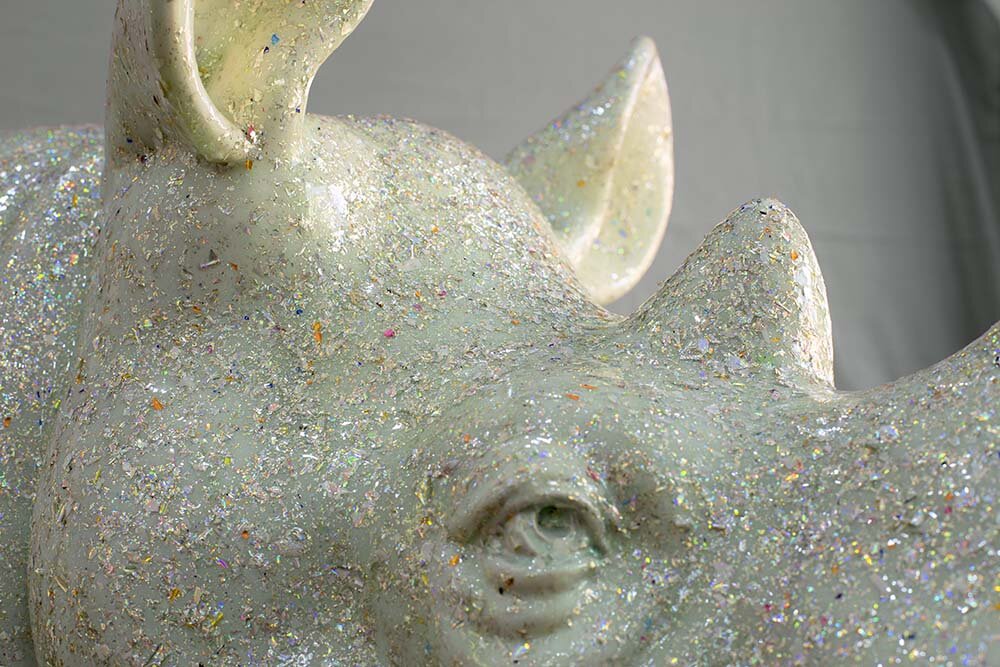Tusk Rhino Trail
City-wide public art installation
St Pancras Station, London
2018
The rapid expansion of the human population is having a devastating impact on the natural world.
Let’s empower ourselves to instead live as one, with respect and empathy for all life. This artwork has been created with data scraped from over 500 used compact disks, which have been contributed by members of the public.
The Tusk Rhino Trail, kindly curated for the charity by Chris Westbrook, celebrates the magnificence of the rhino, and draws attention to the severe threat of poaching to their survival. Each rhino has been specially designed, decorated and embellished by internationally renowned artists.
Environmental Artists
Tusk’s crash of stunning rhinos have been painted by Ronnie Wood, Marc Quinn, Gavin Turk, Axel Scheffler, the Chapman Brothers and other leading international artists: Charming Baker, Glen Baxter, Nick and Rob Carter, Eileen Cooper, Nancy Fouts, Nick Gentry, Zhang Huan, Patrick Hughes, David Mach, Gerry McGovern, Harland Miller, Mauro Perruchetti, Dave White, David Yarrow, Jonathan Yeo.
Ending Illegal Wildlife Trade
Rhino populations across Africa are in critical danger, threatened by a global poaching crisis. The illegal wildlife trade is now the fourth largest criminal industry in the World after drugs, arms and human trafficking.
Thanks to the actions of determined conservationists, governments and donors, global rhino population numbers are on the rise. But further action is needed to ensure this trend continues and success is not overturned.
Gathering Support
The high profile sale of works will be held the same week world leaders gather in London to attend the International Conference on the Illegal Wildlife Trade. The conference is an important opportunity for governments to make the commitments needed to end the illegal wildlife trade.
The trail is presented by ISPS Handa in partnership with Land Rover. We are thankful to Pickfords for logistical support. Each rhino is generously sponsored by a Tusk supporter or partner.
Duke of Cambridge to attend Tusk Rhino Trail
Article by Jess Ilse for Royal Central
Prince William will attend an event celebrating the Tusk Rhino Trail in the Kensington Palace Gardens next Monday.
The Tusk Rhino Trail is an art installation that has popped up all over London and celebrates the African rhino to highlight the animal’s dwindling population due to illegal poaching.
Kensington Palace
“The illegal wildlife trade is now the fourth largest criminal industry in the world, after drugs, arms and human trafficking,” says Kensington Palace.
HRH The Duke of Cambridge met contributing artists from the Tusk Rhino Trail at an event at Kensington Palace to raise awareness of the plight of the rhino and the action being taken to protect the species.
When the Tusk Rhino Trail is installed at the Kensington Palace Gardens, Prince William will see seven of the 21 rhinos that were designed by internationally recognized artists; and meet illustrator Axel Scheffler, who has designed one of the rhinos.
The Tusk Rhino Trail will be displayed at various iconic spots throughout London until World Rhino Day on 22 September. Afterwards, they will be auctioned at Christie’s on 9 October to raise funds for Tusk.
Sustainable Development and Education
Tusk was founded in 1990 and has invested over £40 million into field projects across 21 African countries to “protect wildlife, and help to alleviate poverty through sustainable development and education.”
Prince William is active in supporting the end of poaching and illegal wildlife trade, and has been the Royal Patron of Tusk Trust since 2005.
On World Rhino Day in 2016, Prince William spoke of the need to stop poaching African rhinos.
The rhino, he said, is “a species that, due to demand for its horn, is being killed at a rate of nearly three animals a day. Rhinos face extinction in our lifetimes as we struggled to correct lies about the supposed benefits of using its horn as a drug.
Iconic Species
“It is some of the world’s poorest people who will suffer when their natural resources are stripped from them illegally and brutally. It is families in the world’s most vulnerable regions who suffer when two rangers are killed every week on the frontline of this fight… Ladies and gentlemen, I am not prepared to be part of a generation that lets those iconic species disappear from the wild.”
Black Rhino facts
Status: Critically Endangered
Lifespan: 40 – 50 years
Population: Declined by an estimated 97% since 1960, mainly as a result of poaching. Today, about 5000 remain in the wild.
Scientific name: Diceros bicornis
Size: 130cm – 180cm (adult, at shoulder)
Weight: 800 – 1,400 kg; 1700-3000 lbs
Habitat and Range: Eastern and southern Africa. The highest densities of rhinos are found in savannahs and bushveld areas.
Diet: Black rhinos are browsers and eat mainly acacia’s and other woody species.
Threats: In recent years, there has been an increase in the black-market price for rhino horn leading to an increase in poaching.
Find out more about the Black Rhino and other endangered species on the Tusk website.










Environmental art campaign
Cambodia and Singapore
2017